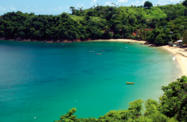Trinidad and Tobago has received a boost in its efforts to expand tourism, with the number of cruise ships visiting the country expected to increase by 50% in the near term.

Launching the 2017-18 winter season in mid-October, Shamfa Cudjoe, the minister of tourism, said 71 cruise liners were expected to call into T&T ports over the period, an increase on the 47 visits initially planned.
Tobago, traditionally the main destination for maritime tourism in the country, will see the majority of this increase: 47 liners will dock there, while 24 ships will stop in Trinidad.
As a result, authorities are hopeful that total visitors arriving by cruise ship could reach 200,000 over the season, up from original estimates of around 135,000, and considerably higher than 2015-16 levels of 100,800.
Before the announcement of increased cruise ship calls, the World Travel & Tourism Council (WTTC) forecast that 463,000 international tourists would visit T&T in 2017, with the rise of arrivals to boost direct and indirect revenue generated by the sector.
Tourism key to economic diversification strategy
The increase has largely been attributed to the effects of Hurricanes Irma and Maria, which have caused damage in parts of the Caribbean, prompting many cruise lines to seek undamaged ports, such as those in T&T, to fill gaps on their itineraries.
However, it also comes on the back of a concerted effort to attract more cruise tourism to T&T, with authorities launching a targeted marketing campaign aimed at both domestic and international markets, along with improving port facilities and tourist offerings on the islands.
These developments have formed part of the broader economic strategy, with tourism highlighted as an industry central to plans to diversify the national economy away from a reliance on hydrocarbons revenues.
The sector directly accounted for 2.9% of GDP last year, according to the WTTC, with this expected to rise to 3.8% this year, leaving significant room for additional growth.
T&T should also benefit from broader efforts to promote Caribbean tourism in the US, with the winter season’s increased cruise ship arrivals to help boost the country’s profile as a holiday destination and provide it with an opportunity to expand its regional market share.
Measures taken to improve tourism offerings
While T&T has a great opportunity to expand its tourism base, stakeholders have highlighted a number of shortcomings to be addressed in order to realise its potential.
Despite ranking third in the Caribbean, T&T was rated 73rd out of 136 countries in the World Economic Forum’s Travel & Tourism Competitiveness Index 2017, down four places from the previous report in 2015.
The report cited cultural resources and business capital, safety and security, and the prioritisation of travel and tourism as areas requiring improvement, while industry figures have long called for upgrades to be made to port infrastructure.
The national budget for 2018 has allocated funding towards improving some of these issues, including security, while it also contains measures aimed at supporting cultural activities and the tourism industry more broadly.
In addition, Colm Imbert, the minister of finance, announced several initiatives aimed at directly supporting the expansion of cruise and maritime tourism. Along with more general measures, such as increasing funding availability for accommodation upgrades and extending repayment terms for state-backed loans to tourism operators, the minister said the government was working to lift the country’s cruise tourism profile.
“We have already started to forge closer links with cruise lines and to strengthen our marketing efforts to increase the number of port calls to our destination,” he told Parliament in October. “We are working to provide an enhanced visitor experience for our cruise ship visitors.”
The yachting segment of the tourism industry is another that stands to benefit from the 2018 budget, with the government rolling out a new policy that aims to improve the competitiveness of the industry, which currently consists of around 180 firms and employs approximately 1700 people.
Measures to boost the sector include the deployment of public-private partnership models to develop marinas in Tobago, supporting the expansion of the maritime services segment through the establishment of yacht repair and maintenance facilities, and streamlining bureaucratic procedures for arriving and departing vessels.


